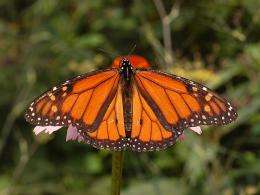Coldness triggers northward flight in migrating monarch butterflies, study shows

Each fall millions of monarch butterflies from across the eastern United States begin a southward migration in order to escape the frigid temperatures of their northern boundaries, traveling up to 2,000 miles to an overwintering site in a specific grove of fir trees in central Mexico. Surprisingly, a new study by scientists at the University of Massachusetts Medical School published in Current Biology, suggests that exposure to coldness found in the microenvironment of the monarch's overwintering site triggers their return north every spring. Without this cold exposure, the monarch butterfly would continue flying south.
These findings help explain why monarch butterflies transverse such long distances to overwinter at a relatively small region roughly 300 square miles in size atop frost-covered mountains. Upon arrival in November, the monarchs begin to congregate in tightly packed clusters in a few isolated locations in the high altitude coniferous forests. Both the clustering and the forest cover provide a microenvironment that protects against environmental extremes – the temperature remains low enough to keep metabolic demands low but not cold enough to cause freezing – and ultimately triggers their return north in the spring.
It also suggests that these delicate creatures may be influenced by and vulnerable to global climate changes, say researchers. "The temperature of the microenvironment at the overwintering sites is a critical component for the completion of the migration cycle," said Steven M. Reppert, MD, professor of neurobiology and senior author of the study. "Without this thermal stimulus, the annual migration cycle would be broken, and we could have lost one of the most intriguing biological phenomena in the world."
Though accomplished in a single calendar year, it takes at least three generations of monarch butterflies to complete a single migratory journey. The monarchs that return to Mexico each year have never been to the overwintering sites before, and have no relatives to follow on their way. The biological and genetic mechanisms underlying their incredible journey have intrigued scientists for generations.
Earlier work by Reppert's group found that monarchs rely on a time-compensated sun compass to direct their navigation south. Their new research shows that those same systems are responsible for guiding them north each spring.
This alone, however, didn't explain what was triggering the change in direction each spring. To find out, Patrick Guerra, a postdoctoral fellow in Reppert's lab at UMass Medical School and first author on the Current Biology study, collected wild monarchs at the start of their migration in the fall and subjected the monarchs to the same temperature and light levels they would experience in their overwintering ground in Mexico. When the monarchs were studied in a flight simulator 24 days later, instead of resuming their southward journey, the butterflies headed north.
Further study confirmed that changes in temperature alone altered the flight direction of the monarch butterflies. Those subjected to cold oriented north; monarchs who were protected from the cold would continue to orient south.
These findings, coupled with newly available genetic and genomic tools for monarchs, will lead to new insights about the biological processes underlying their remarkable migratory journey.
"The more we learn, the clearer it becomes that the monarch migration is a uniquely fragile biological process," said Reppert. "Understanding how it works means we'll be better able to protect this iconic system from external threats such as global warming."
More information: dx.doi.org/10.1016/j.cub.2013.01.052
Journal information: Current Biology
Provided by University of Massachusetts Medical School














